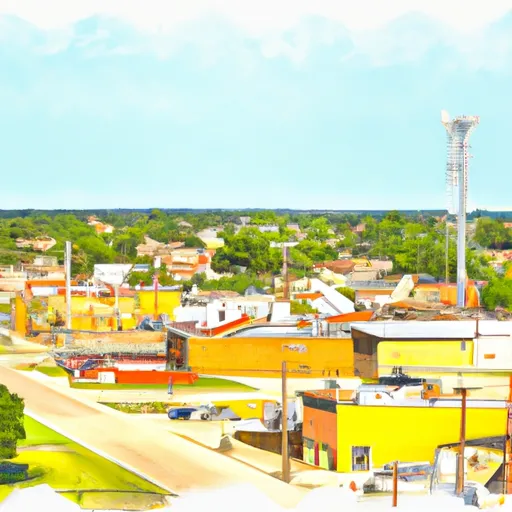-
 Snoflo Premium
Snoflo Premium
Get unlimited access to all our content
With no Ad interruptions! - Start Your Free Trial Login with existing account
Nordheim
Eden Index
Climate
7.5
•
Recreation
•
Community
0.9
•
Safeguard
3.2/10

Nordheim, Texas, a small town located in DeWitt County, has a humid subtropical climate characterized by hot summers and mild winters. Summers often bring high temperatures in the 90s, while winters average in the 50s. The region receives an average annual rainfall of around 34 inches. Nordheim lies within the Guadalupe River watershed and is bordered by several creeks, providing a diverse hydrology system. Outdoor enthusiasts can enjoy various recreational activities in the area, including fishing, boating, and swimming in the nearby Guadalupe River. The town also has parks and nature trails that offer opportunities for hiking, bird watching, and picnicking, making it an ideal destination for nature lovers.
What is the Eden Index?
The Snoflo Eden Index serves as a comprehensive rating system for regions, evaluating their desirability through a holistic assessment of climate health, outdoor recreation opportunities, and natural disaster risk, acknowledging the profound impact of these factors on livability and well-being.
Climate Health Indicator (CHI): 7.5
Nordheim receives approximately
817mm of rain per year,
with humidity levels near 90%
and air temperatures averaging around
21°C.
Nordheim has a plant hardyness factor of
9, meaning
plants and agriculture in this region tend to thrive here all year round.
By considering the ideal temperature range, reliable water supplies, clean air, and stable seasonal rain or snowpacks, the Climate Health Indicator (CHI) underscores the significance of a healthy climate as the foundation for quality living.
A healthy climate is paramount for ensuring a high quality of life and livability in a region, fostering both physical well-being and environmental harmony. This can be characterized by ideal temperatures, reliable access to water supplies, clean air, and consistent seasonal rain or snowpacks.
Weather Forecast
Streamflow Conditions
San Antonio
Area Rivers
San Antonio
Snowpack Depths
San Antonio
Reservoir Storage Capacity
San Antonio
Groundwater Levels
Recreational Opportunity Index (ROI):
The Recreational Opportunity Index (ROI) recognizes the value of outdoor recreational options, such as parks, hiking trails, camping sites, and fishing spots, while acknowledging that climate plays a pivotal role in ensuring the comfort and consistency of these experiences.
Access to outdoor recreational opportunities, encompassing activities such as parks, hiking, camping, and fishing, is crucial for overall well-being, and the climate plays a pivotal role in enabling and enhancing these experiences, ensuring that individuals can engage in nature-based activities comfortably and consistently.
Camping Areas
| Campground | Campsites | Reservations | Toilets | Showers | Elevation |
|---|---|---|---|---|---|
| McKinney Falls State Park | 89 | 571 ft | |||
| Nasking Rec Military - Kingsville NAS | None | 49 ft | |||
| Kaufer - Hubert - SeaWind RV Park | 134 | 9 ft | |||
| Lake Wood Rec Area | 25 | 298 ft | |||
| John J. Sablatura Park | None | 77 ft | |||
| Camp Mabry Military | None | 654 ft | |||
| Labonte Park | 20 | 7 ft | |||
| Palmetto State Park | 40 | 336 ft | |||
| Lockhart State Park | 20 | 499 ft | |||
| Independence City Park | 21 | 270 ft |
Nearby Fishing
Nearby Ski Areas
Catastrophe Safeguard Index (CSI):
The Catastrophe Safeguard Index (CSI) recognizes that natural disaster risk, encompassing floods, fires, hurricanes, and tornadoes, can drastically affect safety and the overall appeal of an area.
The level of natural disaster risk in a region significantly affects safety and the overall livability, with climate change amplifying these risks by potentially increasing the frequency and intensity of events like floods, fires, hurricanes, and tornadoes, thereby posing substantial challenges to community resilience and well-being.
Community Resilience Indicator (CRI): 0.9
The Community Resilience Indicator (CRI) recognizes that education, healthcare, and socioeconomics are crucial to the well-being of a region. The CRI acknowledges the profound impact of these elements on residents' overall quality of life. By evaluating educational resources, healthcare accessibility, and economic inclusivity, the index captures the essential aspects that contribute to a thriving community, fostering resident satisfaction, equity, and social cohesion.

